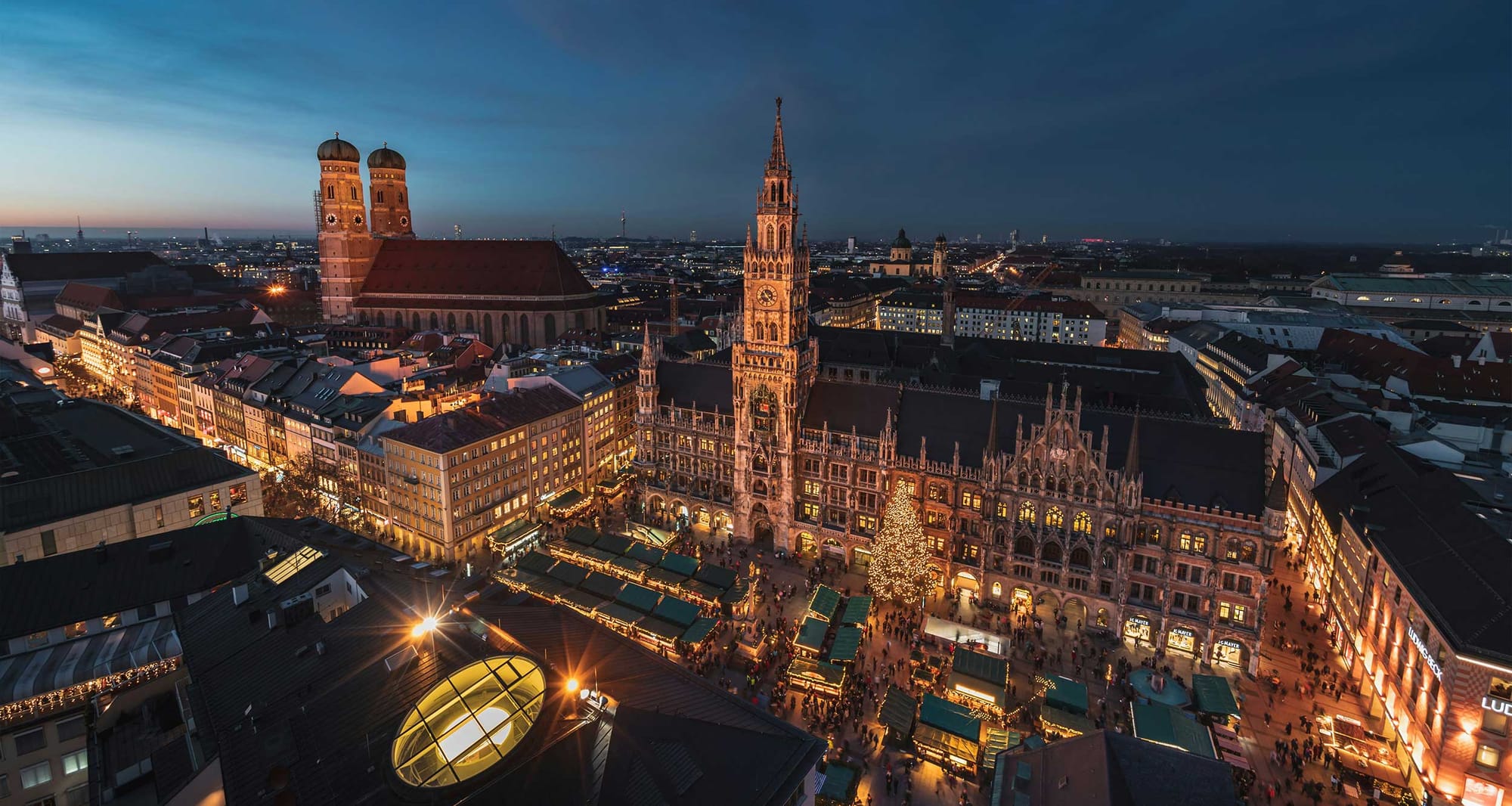
There is more to Bavaria (and Munich) than beer. Don’t get me wrong, I love a good brew, but I traveled to Munich to satisfy a craving for history. I found that and a whole lot more, and I’m excited to share it with you in this wheelchair accessible guide and review of the top things to do in Munich, Germany. While I didn’t see everything, I hit most of the popular attractions, and I’m already planning my next trip to see the rest.
BMW Museum
Visit Munich’s BMW Museum for a look behind the scenes of the popular vehicle manufacturer – Germany’s largest. The museum is located across the street from the BMW Welt (described below), and within walking distance of Olympiapark, the center of the 1972 Olympic Games.
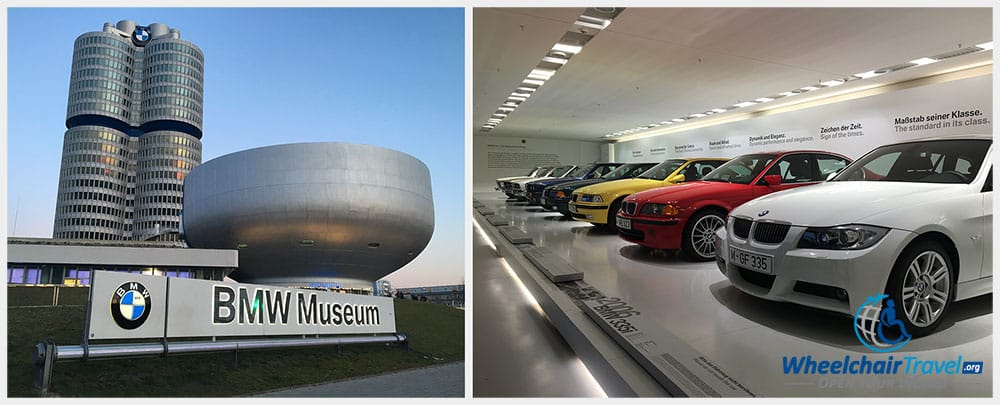
The facility is spectacular in design, both inside and out – precisely what you would expect from a luxury European automaker. The exhibits are spread across multiple floors, and focus in large part on the company’s 100 year history. BMW vehicles from the early years to the present day are on display. While I am not a car fanatic, it was interesting to observe the evolution in design, and learn about the company’s beginnings in 1916. The facility is wheelchair accessible, with access to all areas available via elevators and ramps. For a more detailed accessibility review, please see my blog post dedicated to my December visit: Visiting Munich’s BMW Museum In A Wheelchair.
Nearest U-Bahn station: 0.5 km to Olympiazentrum – U3 & U8.
BMW Welt
The BMW Welt is an exhibition facility, located across the street from, and connected by bridge to, the BMW Museum. The Welt showcases current BMW car models, allowing customers to experience (and even buy!) the latest vehicles. It is home to multiple BMW brands, including Mini Cooper and Rolls Royce.
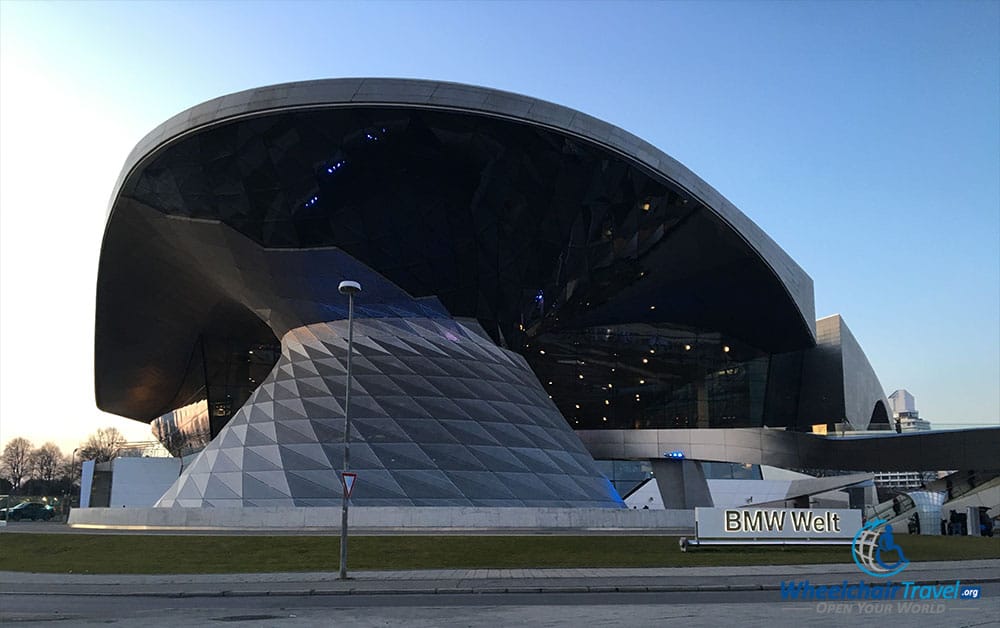
Visitors to the museum should definitely make a quick stop at the Welt, to see up close how far BMW innovation has come. The building’s architecture, seen in the photograph above, is also worth admiring. Admission to the Welt is free for all, and elevators make all levels of the building wheelchair accessible. More photos from my December visit are available here.
Nearest U-Bahn station: 0.5 km to Olympiazentrum – U3 & U8.
Church of the Holy Ghost
Although St. Peter’s Church is the most visited by tourists in Munich, it was the Church of the Holy Ghost, or Heiliggeistkirche, that I was most excited to see. A Gothic Hall style Church structure, it has a long history, beginning with its founding as part of the Hospice of the Holy Ghost in the 14th century. It was remodeled in the 1700s, and expanded after 1885. The tower/steeple at the top of the building was erected in 1730. Much of the Church was rebuilt following damage caused by World War II.
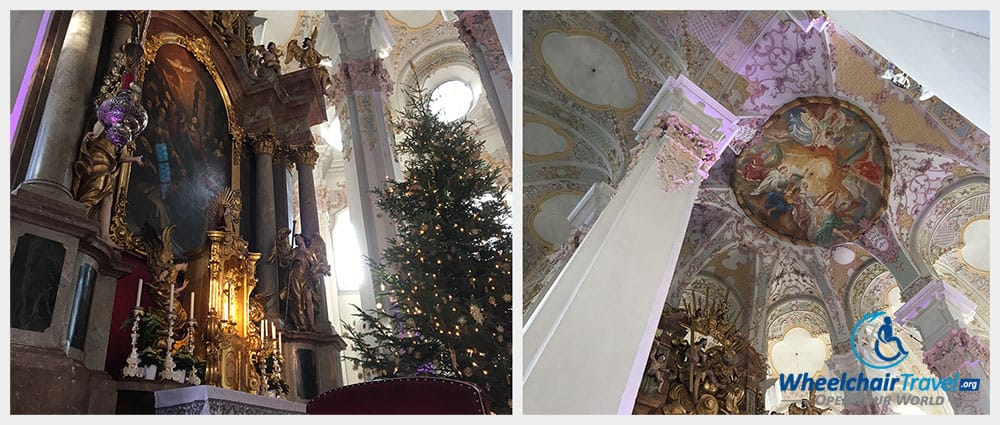
The parish is part of the Roman Catholic Archdiocese of Munich and Freising. What attracted me to the Church of the Holy Ghost were numerous objects of intense beauty and historical value. The building shows its age, but remains beautiful in spite of the wear. The altar is magnificent and beautiful, and my attention was immediately drawn to the Tabernacle. Visit the Church website at www.heilig-geist-muenchen.de (German only) for more information.
Nearest S+U-Bahn station: 3 blocks to Marienplatz – S1-S4, S6-S8, U3 & U6.
Dachau Concentration Camp
All visitors to Munich should take the emotional tour of the Dachau Concentration Camp Memorial Site. The camp is located 10 miles outside of the city and is accessible via public transportation. Dachau was the first internment and forced labor camp constructed by the Nazi regime – it opened in 1933 and was liberated in 1945, with 30,000 prisoners still inside.
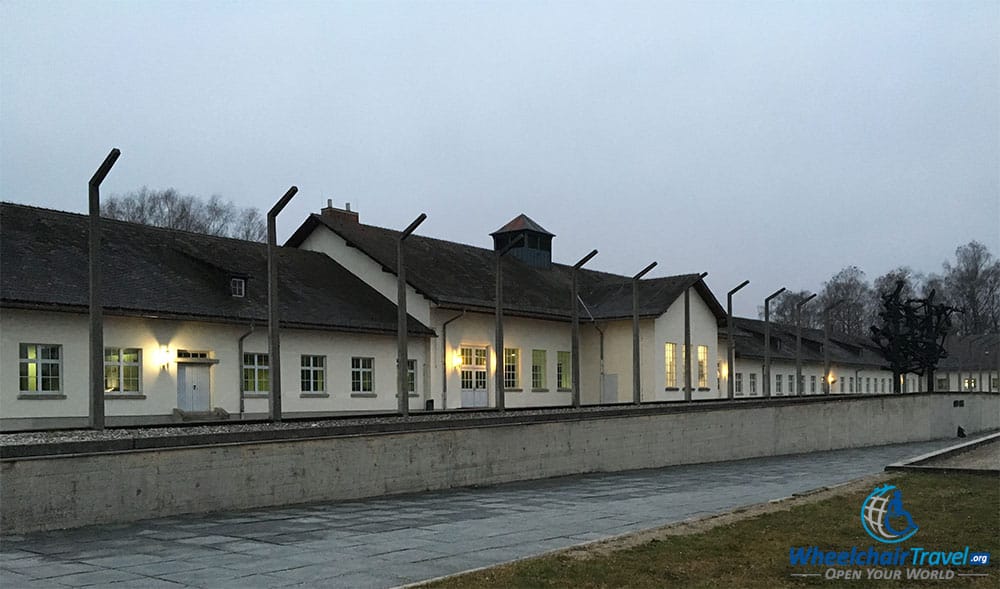
The camp includes an extensive permanent exhibition, which explains the camp’s history, and reveals what life was like for the prisoners held there. Nearly all of the buildings are wheelchair accessible, by way of ramps and push-button electronic doors. For an in-depth review of the camp, check out my blog post: Wheelchair Accessible Tour of Dachau Concentration Camp.
Public Transportation: Take the S2 S-Bahn train to Dachau station, then bus #726 directly to the camp.
Deutsches Museum
The largest and most visited museum in Munich is the German Museum of Masterpieces of Science and Technology, or the Deutsches Museum in short. The museum opened in 1903, and its present location is on a small island in the Isar River. The collections are vast, and focus in a multitude of areas under the themes of science and technology. There are more than 20 permanent exhibits, with details available on the museum website at www.deutsches-museum.de. Admission is € 8,50 for adults, and € 5 for seniors and the disabled.
Nearest S-Bahn station: 1 km to Rosenheimer Platz – S1-S4, S6-S8.
Marienplatz & New Town Hall
The New Town Hall, or Neues Rathaus, pictured in the video below, is the architectural fixture of Munich’s central square, Marienplatz. The hall was built between 1867 and 1908, and contains more than 400 rooms in nearly 100,000 square feet of space. The main tower is 85 meters tall (~279 feet), and contains a wheelchair accessible elevator to a viewing platform at its top. The Glockenspiel is a mechanical apparatus that creates a show with 43 bells and 32 life-sized figures. The “shows” occur daily at 11 a.m., 12 p.m. and 5 p.m.
The square, Marienplatz, is within walking distance of numerous other tourist attractions, including the popular St. Peter’s Church. Also in the area is a wide selection of shopping, restaurants and pubs. I even had a chance to top off my iPhone battery in the Apple Store, which was only steps from the square. :p
Nearest S+U-Bahn station: Marienplatz – S1-S4, S6-S8, U3 & U6.
Munich Stadtmuseum
The city museum of Munich was founded in 1888, and is one of the largest museums in the city. The city is predominantly focused on the history of the city, its culture, politics and people. The collections are spread across multiple buildings which surround a courtyard. Among those buildings are the city’s former armory, which was built in 1500, and the medieval royal stables.
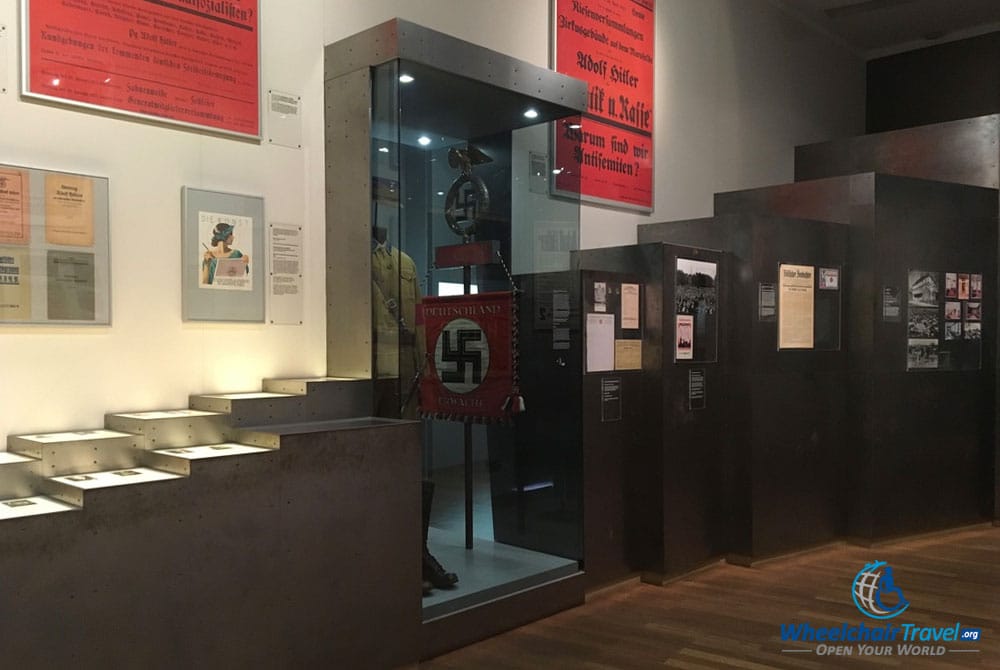
The exhibit of greatest interest to me is titled National Socialism in Munich, which traces the history of Adolf Hitler and the Nazis, with special attention to its most early founding in Munich. The museum and its exhibits are wheelchair accessible through the use of ramps, lifts and elevators. A dedicated restroom for people with disabilities and their carers is located on the ground floor, near the entrance and welcome desk.
For more information on the specific collections, visit the museum’s website at www.muenchner-stadtmuseum.de. Admission for adults is € 7, while seniors and people with disabilities received a reduced price of € 3,50.
Nearest S+U-Bahn station: 0.5 km to Marienplatz – S1-S4, S6-S8, U3 & U6.
Olympiapark
The Olympiapark was constructed for the 1972 Summer Olympics, and was a major center of the games. The area consists of four major areas: The Olympic Area, with all of the major stadiums and event halls; the Olympic Village, which is now used for private and student housing; Olympic Media City, now a major shopping center; and Olympic Park, which includes a mountain and a lake. Pathways run throughout these areas, and all are wheelchair accessible. The Olympic Park has some steep terrain leading up to the mountain, which offers an excellent overlook for the surrounding structures, stadiums and the nearby BMW Museum.
Nearest U-Bahn station: 0.5 km to Olympiazentrum – U3 & U8.
Olympic Tower
Construction of the Olympic Tower was completed in 1968, well before the 1972 Olympics. The top floor stands at 597 feet, while the tip of the antenna spire reaches to 955 feet. Like most towers of this era, it wasn’t built solely for observation and entertainment – to this day, the tower is still responsible for transmitting the FM radio signals for 7 stations, along with signals for both digital radio and television.
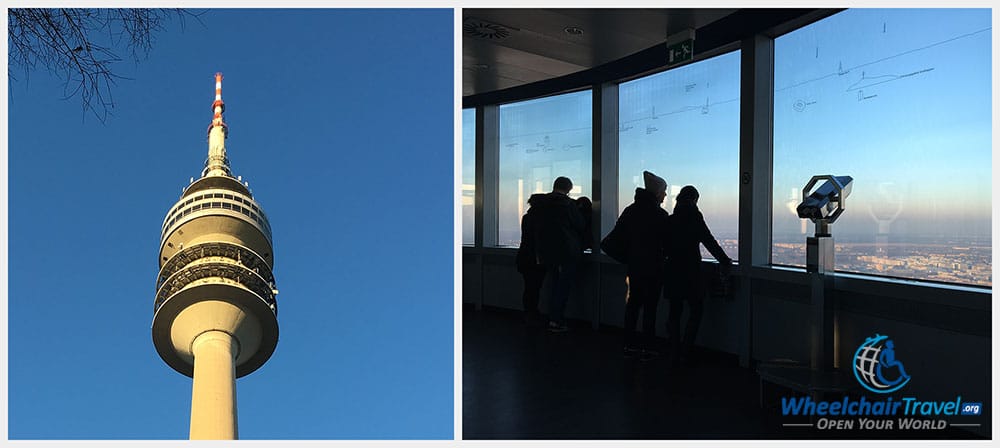
Pictured above is a view of the tower’s interior viewing deck. There is also an outdoor, rooftop deck, but it can only be reached by stairs. In general, I found the views from the interior observation area to be less than impressive, due to the distance from the city’s downtown district. Tickets to access the tower are € 7 for adults, but a “1 carer accompanying a severely disabled person” is admitted free. My sister and I qualified under this provision. More information on the Olympic Tower can be found on its website at www.olympiapark.de.
Nearest U-Bahn station: 0.5 km to Olympiazentrum – U3 & U8.
St. Peter’s Church
This church is the oldest in the city, and it traces its history to a time before Munich actually existed. The first religious organization in the area was a group of monks who lived on a nearby hill in the 8th century.
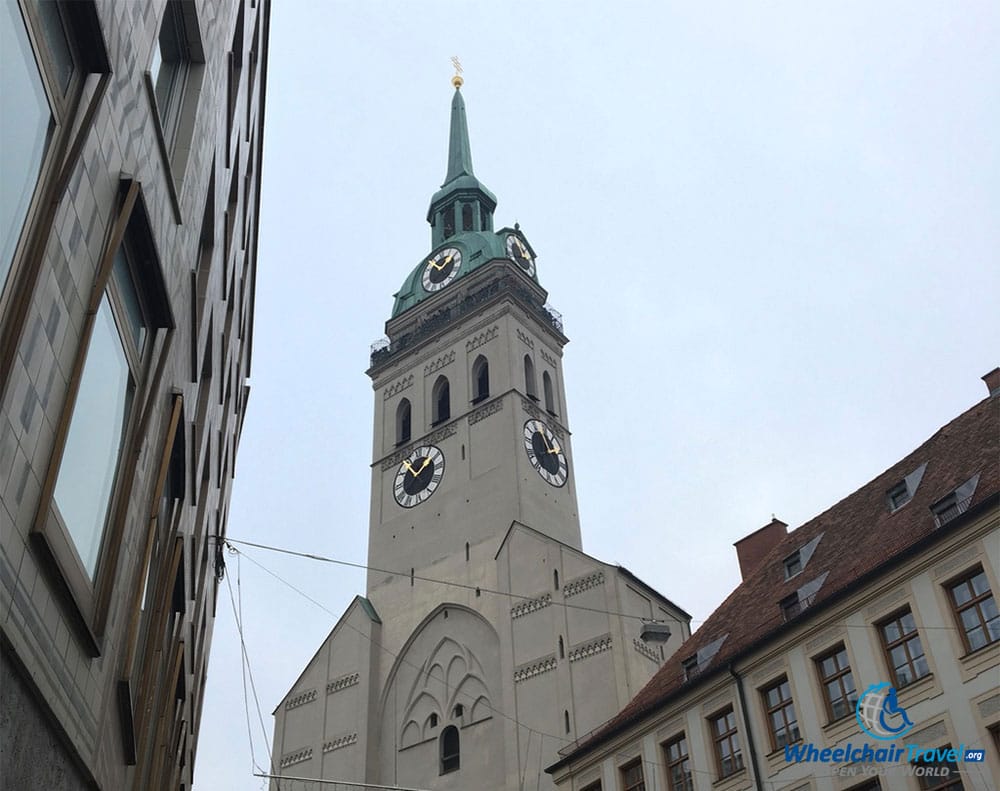
The present building was consecrated in 1368, and received its steeple in the 17th century. The church is a parish in the Roman Catholic Archdiocese of Munich-Freising. The sanctuary is accessible to wheelchairs, but the observation area at the top of the tower is not – it can only be accessed via stairs. The church has a website, www.alterpeter.de, but it is only available in German language. As a Roman Catholic myself, I enjoyed visiting the parish and taking an opportunity to pray there. Since the spectacular views from the tower attract large numbers of tourists, it may not be the best choice if you would like to pray. The Church of the Holy Ghost is only one block away, and was my favorite of the downtown parishes.
Nearest S+U-Bahn station: 2 blocks to Marienplatz – S1-S4, S6-S8, U3 & U6.



